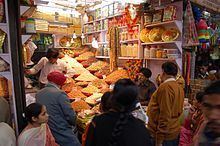Country India District Central Delhi Time zone IST (UTC+5:30) | Union Territory Delhi Metro Chandni Chowk PIN 110 006 | |
 | ||
Similar | ||
Haryanvi tadka top places to eat in chandni chowk old delhi
The Chandni Chowk is one of the oldest and busiest markets in Old Delhi, India. Chandni Chowk is located close to Old Delhi Railway Station. The Red Fort monument is located within the market. It was built in the 17th century by Mughal Emperor of India Shah Jahan and designed by his daughter Jahanara. The market was once divided by canals (now closed) to reflect moonlight and remains one of India's largest wholesale markets.
Contents
- Haryanvi tadka top places to eat in chandni chowk old delhi
- Map of Chandni Chowk New Delhi Delhi
- Meri dilli delicacies at chandni chowk
- History
- Community
- Religious buildings
- Haveli
- Shops
- Restaurants and eateries
- Popular culture
- References
Map of Chandni Chowk, New Delhi, Delhi
Meri dilli delicacies at chandni chowk
History
The market's history dates to the founding of the capital city of Shahjahanabad when Emperor Shah Jahan established the Red Fort on the banks of the Yamuna River beside his new capital.
Chandni Chowk, or the Moonlight Square, was designed and established by Princess Jahanara Begum, Shah Jahan’s favourite daughter, in 1650 CE. Originally containing 1,560 shops, the bazaar was 40 yards wide by 1,520 yards long. The bazaar was shaped as a square was given elegance by the presence of a pool in the centre of the complex. The pool shimmered in the moonlight, a feature which was perhaps responsible for its name. Shops were originally built in a half-moon shaped pattern, now lost. The bazaar was famous for its silver merchants, which also have contributed to the name as silver is referred to as Chandi in Hindi, a slight variation of which forms Chandni.
The pool in the chowk was replaced by a clock tower (Ghantaghar) until the 1950s. The center of the market is still referred to as Ghantaghar.
Chandni Chowk was once the grandest Indian market. Mughal imperial processions passed through Chandni Chowk. The tradition was continued when Delhi Durbar was held in 1903. Delhi Town Hall was built in 1863 by the British.
Chandni Chowk runs through the middle of the walled city, from the Lahori Gate of the Red Fort to Fatehpuri Masjid. Originally, a canal ran through the middle of the street. It was initially divided into three sections:
Later choked with congestion, the market retains its historical character. The following terms are generally used to describe the buildings and the streets:
Community
On both sides of the wide Chandni Chowk are historical residential areas served by narrow lanes (gali).
Religious buildings
Delhi's most famous mosque, Jama Masjid, built in 1650 in the vicinity, is near famous religious shrines, belonging to multiple religions. Starting from the Red Fort, the street has:
Haveli
Historic mansions include:
Shops
Chandni Chowk's speciality is its variety and authenticity: food, delicacies and sweets of more than 1,000 kinds, sarees with chikan and zari. Narrow lanes host shops sell books, clothing, electronic, consumer goods, shoes and leather goods. It is the location of the original Haldiram's and brands such as Gianis. A particular local delicacy are the jalebis, which are fried in pure ghee (clarified butter).
The Cloth Market, supplies home furnishing fabrics, including ready-made items as well as design services.
Nai Sarak is the wholesale market of stationery, books, paper and decorative materials. It house folder stores including SOLO and Shipra. It also offers bridal Saris and Lehengas from DIVASA by Devta Apparels Pvt. Ltd jogiwara, Arun Sarees and Nandlal Silk Mills.
Lal Kuan is a wholesale market for hardware and hotel kitchen equipment. It is adjacent to Tilak Market which is a wholesale market for industrial chemicals.
Dariba is the market for silver and gold jewelry. The popular jewelry stores are Hare ram Hare Krishna and MM Jewellers. This market also offers trophies, shields, mementos and related items.
Restaurants and eateries
Chandni Chowk is home to several famous restaurants/confectioners (halwais)
Popular culture
Chandni Chowk was featured in the 2001 Bollywood film Kabhi Khushi Kabhie Gham where the leading lady Anjali (Kajol) and her sister Pooja (Kareena Kapoor) lived.
In 2008, The Bollywood movie Black and White starring Anil Kapoor, Anurag Sinha, Shefali Chhaya, and Aditi Sharma is set in Chandni Chowk.
In 2009, The Bollywood movie Chandni Chowk to China starring Akshay Kumar, Deepika Padukone, Mithun Chakraborty, and Ranvir Shorey features some scenes depicting the city.
In 2009, The Bollywood movie Delhi-6 starring Abhishek Bachchan, Sonam Kapoor, Waheeda Rehman, Om Puri, Atul Kulkarni and Divya Dutta had its shooting in the ancient Walled City of Old Delhi, centered around Chandni Chowk.
